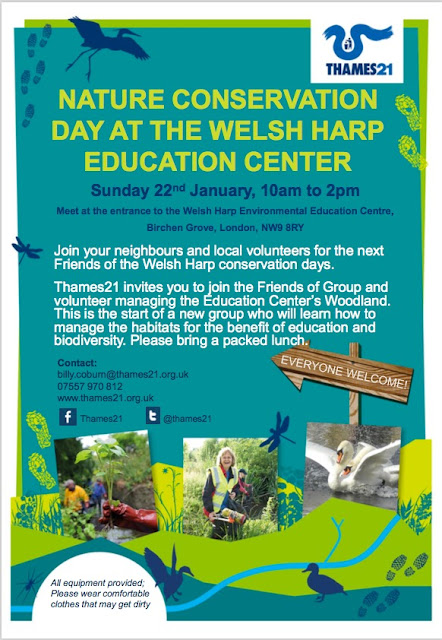Friends of Welsh Harp support the activities of the Welsh Harp
Environmental Education Centre where you will learn how to manage the
habitats in the area. Almost all of the activities we do focus on
improving the natural habitat of the 5 acre woodland for biodiversity,
or make sure the outdoor space is safe for the 30 plus schools Thames21
works with in the area.
All welcome. Under 16’s need to be accompanied by a responsible adult. Please bring a packed lunch. Tea and Coffee will be provided. Exact Meeting location will be at the education centre.
The paragraph immediately below describes one of the previous activities. The exact activity of the day will be selected and emailed out to everyone on the mailing list the week leading up to the event.
We are going to be continuing forming glades as we did during the
first successful event. Thank you to all of those who made that event a
success! A glade is an open area within a woodland. A lot of the glades
around the Welsh Harp Environmental Education Centre are choked with
Ivy, as a consequence, biodiversity is not as high as it could be at
ground level within the woodland.All welcome. Under 16’s need to be accompanied by a responsible adult. Please bring a packed lunch. Tea and Coffee will be provided. Exact Meeting location will be at the education centre.
The paragraph immediately below describes one of the previous activities. The exact activity of the day will be selected and emailed out to everyone on the mailing list the week leading up to the event.
Since July 2016 volunteers have:
1. Formed glades around the woodland area removing ivy to make way for grassland. This increases biodiversity dramatically;If you are not on the mailing list and you wish to be, please email billy.coburn@thames21.org.uk to know exactly what we are going to be doing on the day.
2. Created educational circles in the woodland for the schools using the Education Centre;
3. Cutting back vegetation along the main road creating a path off the road so children don’t have to walk on the road;
4. Maintaining the ponds so grass species do not take over where the water should be;
5. Removing small trees from the wild meadow so the wild meadow habitat, which we don’t have much of at the environmental centre, is not reduced.






